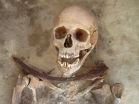(Press-News.org) FLAGSTAFF, Ariz. -- Nov. 26, 2014 -- An international team of scientists from the Translational Genomics Research Institute (TGen) and The Luxembourg Centre for Systems Biomedicine (LCSB) have completed a first-of-its-kind microbial analysis of a biological wastewater treatment plant that has broad implications for protecting the environment, energy recovery and human health.
The study, published Nov. 26 in the scientific journal Nature Communications (DOI: 10.1038/ncomm6603), describes in unprecedented detail the complex relationships within a model ecosystem.
The study focused on biofuel molecules, lipids, which are naturally accumulated by microbial mats and floated on top of wastewater. This is "free energy" as lipids can be converted into diesel fuel.
"Bacterial communities are everywhere, and understanding how they interact is critical to industry, agriculture, the environment and human health," said Dr. Paul Keim, Director of TGen's Pathogen Genomics Division, noting both the academic achievement and the applied implications of these research efforts.
"Basic principles of microbial community function can be established in one setting and then used to generate hypotheses and models applicable to all," said Dr. Keim, who also is a Regents Professor of Microbiology at Northern Arizona University (NAU).
The study's findings corroborate and unify various ecological concepts that have been primarily formulated based on observations in macrobiotic systems such as forests, rivers and oceans, which cannot be experimentally investigated in depth because of the sheer size of these biotopes.
For their analyses of the treatment plant ecosystem, the researchers employed Systems Biology methods. Wastewater destined for treatment comprises energy-rich substrates including fats, proteins, carbohydrates and many other substances that serve as nutrients for the resident bacteria. Every wastewater treatment plant is therefore a complex ecosystem. Countless bacterial species adapt to the living conditions in the water, compete for resources and each find a niche in which they can best survive.
"The techniques developed at LCSB allow us now to unravel these processes very precisely at the molecular level," says Dr. Emilie Muller of LCSB and the study's first author.
The basis for this are the so-called "omics" -- genomics, transcriptomics, proteomics and metabolomics -- combined with new bioinformatic methods for integrated data analysis.
"With these, we can determine from samples which organisms are living in the treatment plant, and what their population sizes, genetic make-up, activities and material turnovers are like. Therefore, there is no longer any need to study bacteria separately in pure cultures," Muller said. "Based on this, we can ultimately model the material flows in the 'treatment plant' ecosystem and describe, for example, which bacterial species will use and consume which substrate and to what degree."
The TGen-LCSB team wants to go further than simply modeling the wastewater treatment plant ecology. Their study aimed to understand what factors determine the species composition and accordingly the balance in the ecosystem.
One species of bacteria grabbed the researchers' attention: Microthrix parvicella, whose genome sequence they first decrypted two years ago. This bacterium can absorb and store an especially large amount of lipids. In winter, up to 50 percent of all bacteria on the surface of treatment tanks belong to this species. This is rather astonishing, given that the amount of lipids in the wastewater is rather low in winter, and Microthrix actually has unfavorable living conditions during that season.
The study found that Microthrix possesses 28 copies of the gene that is chiefly responsible for lipid uptake. The amplification of this gene illustrates how important lipid accumulation is for this organism and its associated community.
"Microthrix is what ecologists call a generalist. The organism can adapt to very many living conditions and thereby dominate the highly fluctuating wastewater treatment plant ecosystem," said Dr. Paul Wilmes, head of the LCSB group "Ecosystems Biology" and the study's senior author.
This is helped, among other things, by the 28 genes for lipid uptake, Wilmes said: "Each copy of the gene is a little different from the others. If the living conditions change, say when the temperature drops or the lipid composition changes, then a different lipid uptake gene adapted to that condition sets in. That way, Microthrix can survive in many different environments."
The study team's translational aim is to boost the activity of Microthrix to remove as many lipids from the wastewater as possible. The lipids from wastewater stored in the bacteria are a renewable energy source because they can be easily converted into biodiesel.
Dr. Lance Price, a TGen team member and study co-author, said such ecosystems research has important medical implications, as well: "The human microbiome is a similar community of microbes. It dominates many tissues and organ systems through microbiome metabolism, interaction with human cells, and its ability to protect us against pathogens. The systematic analysis of the waste water communities will lead to insights for human health as well as translational applications in sustainable energy."
INFORMATION:
About TGen
Translational Genomics Research Institute (TGen) is a Phoenix, Arizona-based non-profit organization dedicated to conducting groundbreaking research with life changing results. TGen is focused on helping patients with cancer, neurological disorders and diabetes, through cutting edge translational research (the process of rapidly moving research towards patient benefit). TGen physicians and scientists work to unravel the genetic components of both common and rare complex diseases in adults and children. Working with collaborators in the scientific and medical communities literally worldwide, TGen makes a substantial contribution to help our patients through efficiency and effectiveness of the translational process. For more information, visit: http://www.tgen.org.
Johns Hopkins researchers report that their test of an interventional X-ray guidance device approved by the U.S. Food and Drug Administration in 2013 has the potential to reduce the radiation exposure of patients undergoing intra-arterial therapy (IAT) for liver cancer.
In a report prepared for presentation Dec. 3 at the 100th annual meeting of the Radiological Society of North America in Chicago (abstract #SSM24-02), the researchers described the results of a clinical trial of the imaging system AlluraClarity, made by Philips Healthcare, on 50 patients with liver cancer. ...
Plasmid DNA attached to the outer surface of a sounding rocket may be able to withstand rocket launch, a period of residence in suborbital space, re-entry, and landing conditions into the Earth's atmosphere, all the while staying intact and active in its function as carrier of genetic information, according to a study published November 26, 2014 in the open-access journal PLOS ONE by Cora Thiel and Oliver Ullrich from University of Zurich and colleagues.
DNA plays an important role as a biomarker for the search of extraterrestrial signatures of life, and scientists are ...
Potential 'vampires' buried in northwestern Poland with sickles and rocks across their bodies were likely local and not immigrants to the region, according to a study published November 26, 2014 in the open-access journal PLOS ONE by Lesley Gregoricka from University of South Alabama and colleagues.
In northwestern Poland, apotropaic funerary rites--a traditional practice intended to prevent evil--occurred throughout the 17th-18th c. AD. Those of the dead considered at risk for becoming vampires for a variety of reasons were given specific treatment, and investigating ...
Shifts in the timing and duration of ice cover, especially the possible lengthening of ice-free periods, may impact polar bears under projected warming before the end of the 21st century, according to a study published November 26, 2014 in the open-access journal PLOS ONE by Stephen Hamilton from University of Alberta and colleagues.
Sea ice across the Arctic is declining and altering physical characteristics of marine ecosystems, and polar bears are vulnerable to these changes in sea ice conditions. The authors of this study used sea ice projections for the Canadian ...
Induced pluripotent stem cells made from patients with a form of blistering skin disease can be genetically corrected and used to grow back healthy skin cells in laboratory dishes, researchers at the Stanford University School of Medicine have found. They've termed the new technique "therapeutic reprogramming."
The skin cells formed normal human skin when grafted onto the backs of laboratory mice, they said.
The findings represent a major advance in the battle against the disease, epidermolysis bullosa, in which the top layer of skin, called the epidermis, sloughs off ...
Some people say that reading "Harry Potter and the Sorcerer's Stone" taught them the importance of friends, or that easy decisions are seldom right. Carnegie Mellon University scientists used a chapter of that book to learn a different lesson: identifying what different regions of the brain are doing when people read.
Researchers from CMU's Machine Learning Department performed functional magnetic resonance imaging (fMRI) scans of eight people as they read a chapter of that Potter book. They then analyzed the scans, cubic millimeter by cubic millimeter, for every four-word ...
Applied to the outer shell of the payload section of a rocket using pipettes, small, double-stranded DNA molecules flew into space from Earth and back again. After the launch, space flight, re-entry into Earth's atmosphere and landing, the so-called plasmid DNA molecules were still found on all the application points on the rocket from the TEXUS-49 mission. And this was not the only surprise: For the most part, the DNA salvaged was even still able to transfer genetic information to bacterial and connective tissue cells. "This study provides experimental evidence that the ...
Scientists investigating the potentially deadly hantavirus have used a novel approach to developing protective antibodies against it. Their work, published in today's online edition of Science Translational Medicine, provides proof of concept for producing antibodies against a broad range of human pathogens.
Hantaviruses cause a condition known as hantavirus pulmonary syndrome (HPS), which has a case fatality rate of 35-40 percent. Currently there are no licensed vaccines, prophylactics, or therapeutics to prevent or treat this highly pathogenic disease.
This research ...
This news release is available in German.
Scientists led by Kristina Djinović-Carugo at the Max F. Perutz Laboratories (MFPL) of the University of Vienna and the Medical University of Vienna have elucidated the molecular structure and regulation of the essential muscle protein α-actinin. The new findings allow unprecedented insights into the protein's mode of action and its role in muscle disorders. The findings, made in collaboration with King's College London (KCL), may lead to improved treatments, and are published in the top-class journal Cell.
Most ...
A popular indigestion medication can increase survival in colorectal cancer, according to research published in ecancermedicalscience. But in fact, scientists have studied this for years - and a group of cancer advocates want to know why this research isn't more widely used.
"Cimetidine is an interesting drug as it's very safe, very well-known, and has clinical results in cancer that have been confirmed in a number of trials," says Pan Pantziarka, lead author of the paper and member of the Repurposing Drugs in Oncology (ReDO) project.
Cimetidine treats indigestion ...




